Hello New York State Farmers and Service Providers,
The purpose of this weekly activity and practical data is to monitor pasture growth rates throughout locations in New York and perhaps on other Northeast farms. Why? So graziers can see when there are fast, medium and slow growth rates in time to make management decisions and track forage inventory. The weekly check-in will also highlight how weather conditions (rainfall, temperature) interact with management decisions (residue height, rest and recovery time) in effecting regrowth in our 2 dozen farmer’s pastures. Things that will be harder to measure are the ancillary aspects of how fertility, soil type, grazing impact and specific farm goals effect growth and ultimately profit. We’re all here to learn in this pilot project.
I expect to get weekly data plus perspectives from our farmer team. As much as possible, Betsy Hicks and I will share their observations and ours, and stories from the field and maybe some decisions we’re considering. One of our main outcomes is to initiate other farmers to also position a grazing stick or yardstick in a pasture and play along with us as knowing your own pasture growth weekly does help with decision-making. To access the weekly reports, go here: Pasture Regrowth Monitoring Project | Powered by Box Here are the growth snapshots. Scroll down to see latest updates and The Grass Whisperer’s Pasture Pontifications:
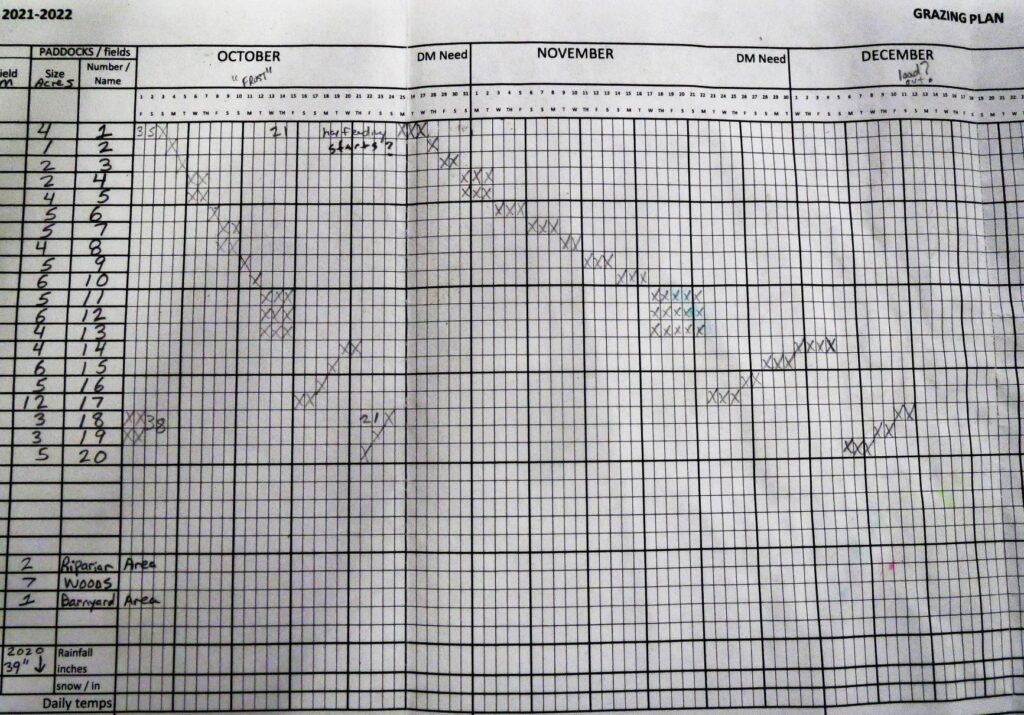
Pasture Pontification – 12/22/2021– Happy Holidays from our family to yours
I reached the end of my grazing season on December 12th, which gave us 234 grazing days. As you can see, the actual grazing basically mirrored the pencil plan. Things that altered our plan were rain and pugging concerns, how much the cows really grazed down a particular paddock and what we wanted for a residual, an unplanned marketing opportunity and working the cows around deer season. I did feed out some hay as planned to keep a good rumen mat. To me, the inventory walk and grazing planning worked. It gives me comfort to know where I’m heading and establishes where I may start in the spring.
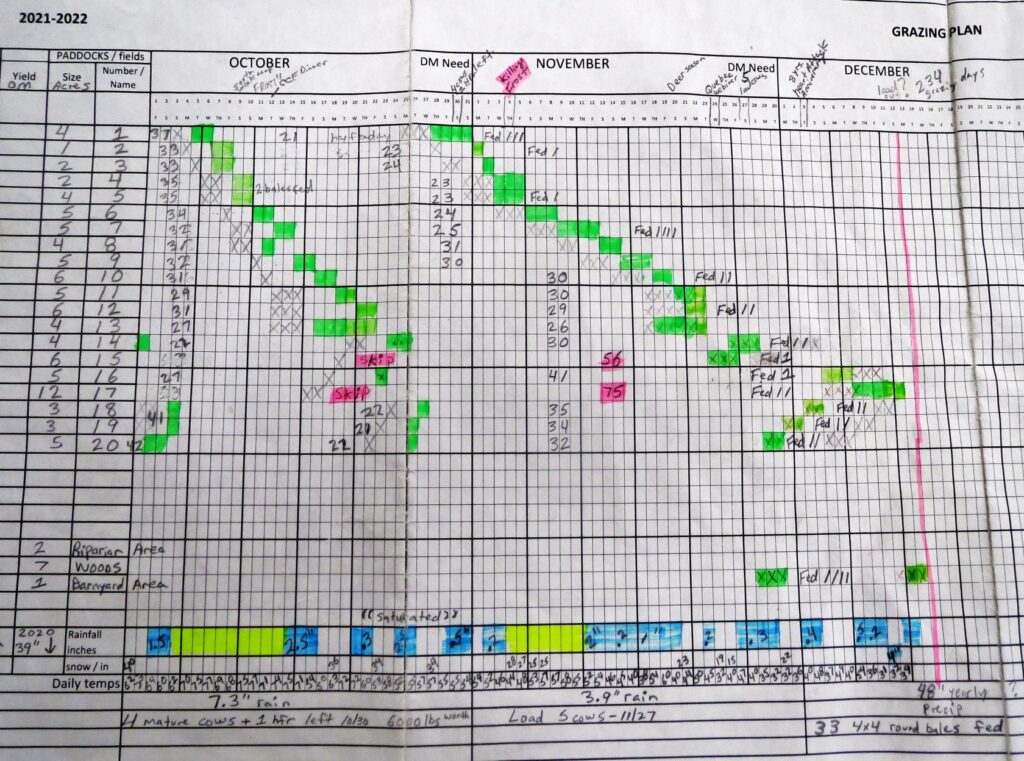
234 days is better than my old 180 day grazing season but doing even better is something I need to learn. So I invested some time recently in visiting 2 outlier farmers (Russ Wilson and John Burns) who are grazing 300 days or more. It was interesting to hear and see how specific “financial and life goals” influence how one looks at extending the grazing season. I learned about matching stocking rates to the environment, gaining recovery time by planting cover crops, using warm season grasses, when to start stockpiling, back-up feeding plans and grazing strategies to deal with not making hay. I hope to write about my adventures soon.
I hope you gained some insight from our pilot project and that some portion will inspire you to get more knowledge or do something positive to gain more inexpensive grazing days in the future. The good news is “better” comes from systems thinking and management time and not necessarily money out of your pocket to implement. Keep striving for your goals, observing, practicing and being flexible. I’m still here after 38 years in the field, if you need me. Thanks and have a prosperous 2022, GW
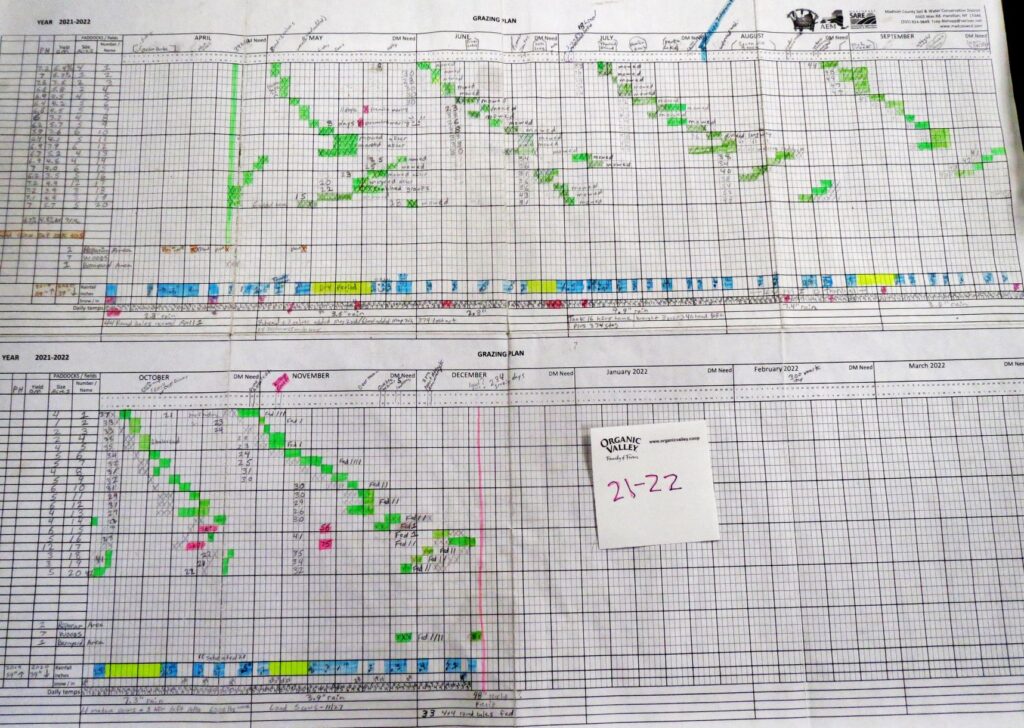
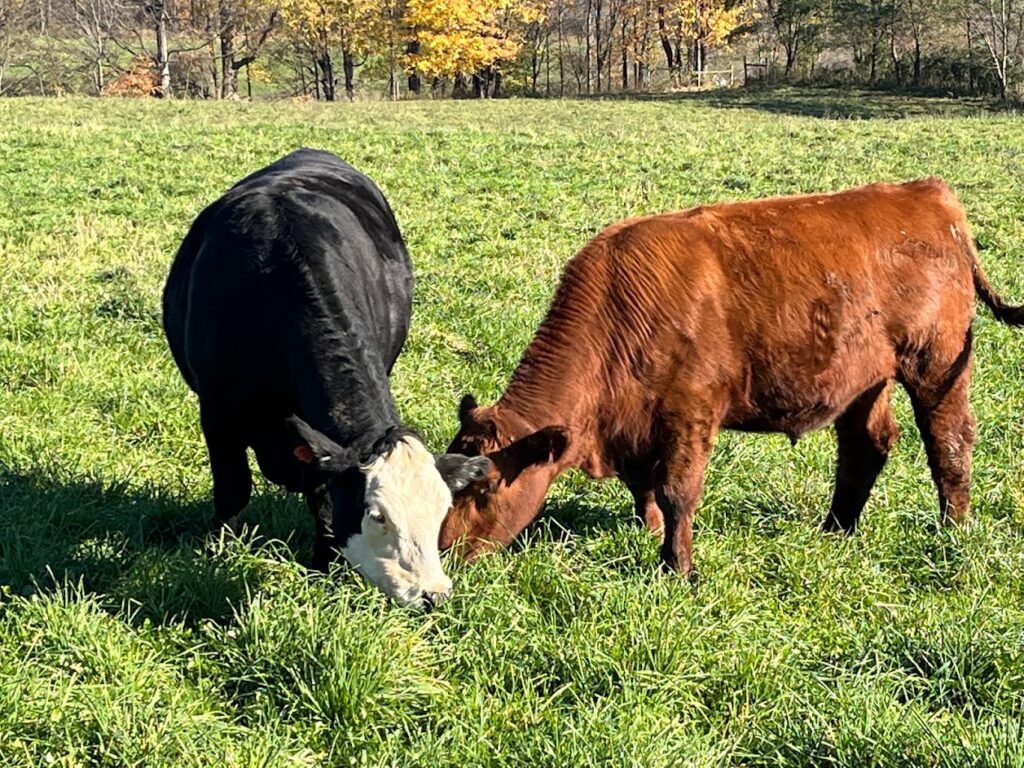
Pasture Pontification – 12/3/2021 Eight years ago, I was building fence around a manure storage at my Conservation District when I suffered a heart attack. As luck or Devine intervention would have it, I was literally 5 minutes to the hospital and the nice medical folks took swift action to bring me back from the brink of a 100% blocked artery. You can read all about it here: https://onpasture.com/2014/01/20/three-stents-for-christmas/
The “incident” proved to me the value of grazing planning, keeping a grazing chart and having paddocks laid out, as my wife was able to move cows flawlessly as I recuperated. It tears me up a bit to think she might have been moving alone for the rest of her life. Maybe it’s why I’m such an advocate for measuring, figuring, implementing and monitoring so if shit happens (and it does), you’ll be better prepared for it. I hope during this holiday season coming up you’ll realize how precious a good life can be.
In the past month, we’ve been carrying out the grazing plan that was set up in pencil back on September 9th. Take a quick look at it because next week I will make the big reveal of what really happened. I can tell you I really enjoyed the dry time after our killing frost on November 4th. It was perfect for grazing stockpile, painting, cleaning up nagging jobs and having time to jump in leaves (https://thegrasswhisperer.com/leaf-therapy/).
You can see the fall grazing progression and other funny reels at my Instagram account: @thegrasswhisperer63
Since then, the ole rains of November have made the management of finishing animals on the money-saving stockpile a daily challenge of finding balance with environmental concerns. Mud sucks, so you must move strategically, which mostly means bigger paddocks and less grazing efficiency. A little hay rolling does help quite a bit when you’re in these conditions and the extra fertility doesn’t hurt either. That’s some of the issue in this long-range soothsaying. What’s the weather going to do to the plan? This is were the Christmas season intersects with grazing, in my humble opinion. It takes a plan with some skill yes. Hope is in there, but hopeful grazing is a fine lunch but a poor supper. Faith is where its at. Faith is the active part of hope. When you commit to doing the right things for the right reasons, faith has a funny way of rewarding you for your toil, as I have personally experienced in my life. Have a great week and give thanks for your many blessings. GW
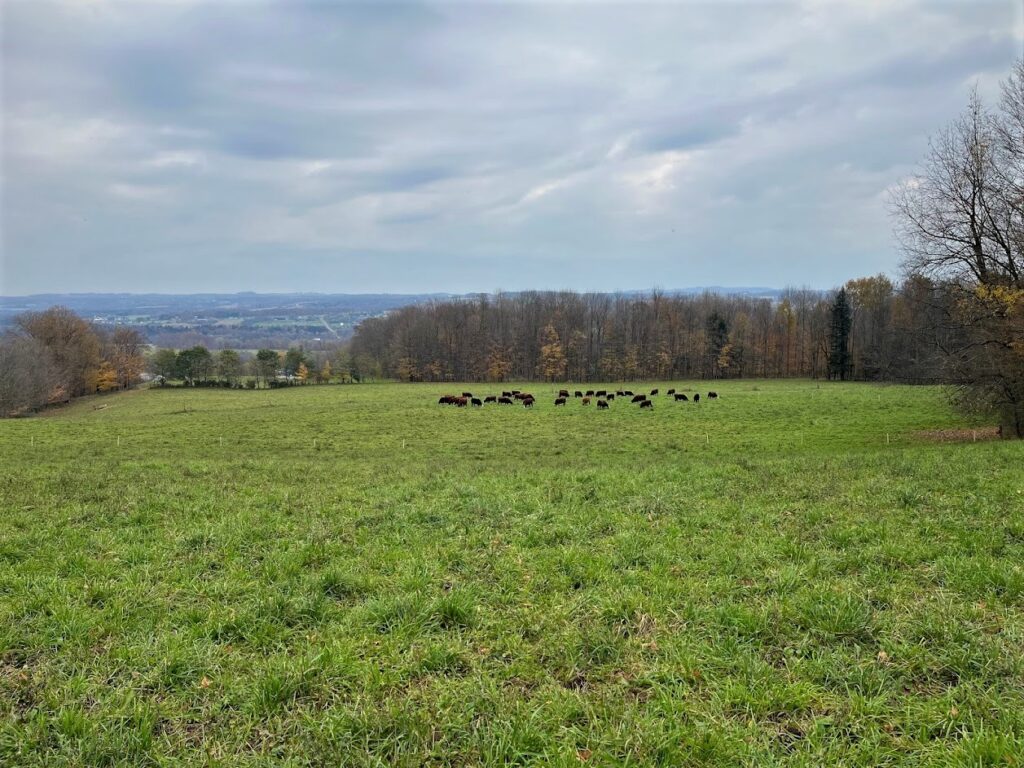
Pasture Pontification – 11/11/2021 It’s Veterans’ Day in which us caretakers of the fallen honor you. https://thegrasswhisperer.com/internal-energy-of-stones-veterans-day-2021/ Thank you to our military men and women and their families for your service. “For the freedom and safety of our nation, we must thank our soldiers for their support and sacrifices; they are ones who sacrifice all the comforts and pleasures for our safety”. Praying for your wellness and happiness. As farmers, we know first-hand the sacrifices that are made for the community of America.
The last 7 day period has been outstanding for grazing on our farm. It’s satisfying to see planning come to fruition. The cows are fat, the forage lush and the leaves sprinkle in enough color to make for a beautiful tapestry with every paddock shift. The weather has also allowed us to catch up on some gnawing tasks before winter. Because today is a metaphorical day, I think this article on the “Gratitude Scavenger Hunt” by OSU Extension Agriculture and Natural Resources Educator, Christine Gelley is a fine way to honor yourselves today. https://u.osu.edu/beef/2021/11/10/observing-an-attitude-of-gratitude/ See ya next week and God Bless, Thanks GW
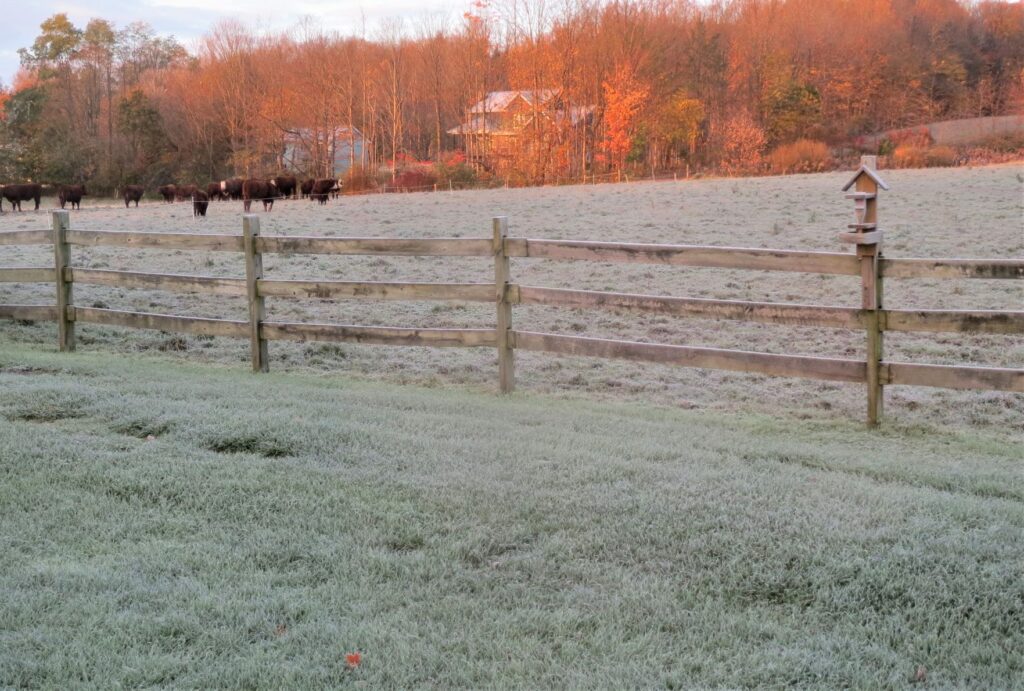
Pasture Pontification – 11/4/2021 As first light finally arrives, the ground is white, signaling what I think is a killing frost at 29 degrees. It’s 25 days late, so thank you Mother Nature for allowing us to grow 10 inches of additional forage. But will those plants still grow a little even after what we think is dormancy? I’ll do a trial on this as the cows move through the 6th and final rotation.
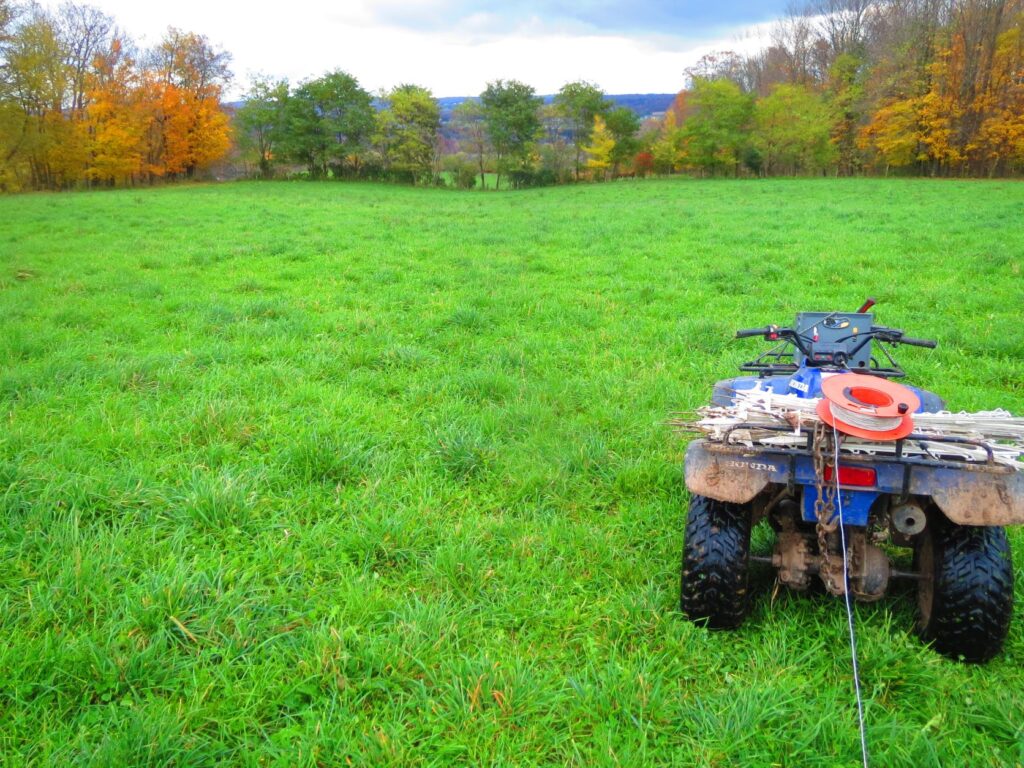
Many team members have commenced expensive feeding, mostly from concern over, saturated pastures, pugging and damage to next year’s sward. We are still on track to keep grazing this very fine stockpile with a bale of hay tagging along for fiber. Growth came along pretty well in my, take 1/3 grazing practice, and allowed me to skip paddocks, 15 & 17 (12acres) on the 5th rotation, so they can have 58 days of recovery before we graze them again. I’m excited to monitor how those will fare in the 2022 spring green-up versus the other paddocks.
So now that Jack Frost came calling and the clocks are moving backward, my focus is on moving cows in the morning and monitoring weather conditions so the animals have plenty of feed and shelter opportunities. I guess, “It will be fun” to see what happens for the next 30 days in my grazing season. All of us would love some free concrete to graze on but that ain’t typical for my farm in the “Perpetual November” scenario, that I’ve experienced over the past 10 years. Even though the grass growth part of this project has basically come to an end today, I’m still going to pontificate each week until I’m done grazing. You all can see if this grazing plan/chart is worth it’s salt to consider using and if the grazing planning process is something you want to tackle for next year. I believe Betsy is writing up her own observations and financial caveats about this experience to share. I’ve said, “If this little project can help just one farmer gain a few more dollars, improve land function and take some time off”, it would be a success. And I’d like you to remember that I not only farm, I am also employed to provide grazing guidance, planning and training in a professional setting with my counterparts in conservation. After 38 years of grazing, I’ve made enough mistakes to be knowledgeable. Give us a call this winter. Thanks, GW
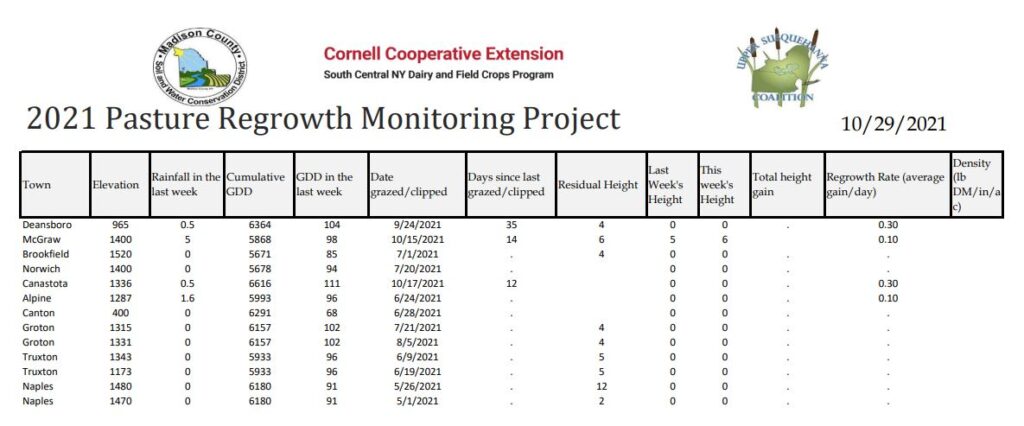
Pasture Pontification – 10/28/2021 Another saturated first part of the week followed by some nice weather and then back to rain again. Some got a light frost but we managed to stay at 34 degrees. I observed 3 inches of grass growth for the week despite the rain. We are now on our final rotation with the herd of 40 basically grazing 1 ½ acres per day with some hay in the feeder cause the forage is so lush. We are strip-grazing our stockpile which are generally rectangle paddocks. Those darn cows act just like the grazing experts say. If you want to trample more, make rectangles. As soon as I start opening the fence they start at one end and walk to the other end looking for the best bite of feed (no matter the width) which fouls the forage with hoof prints in these wet conditions. The trouble is if I concentrate them in a smaller area (squares), there is more grazing efficiency but even more pugging. If I open up a bigger slice they dirty even more. I can’t seem to win in these saturated conditions. What has become abundantly clear is the fact that they are still resistant to grazing lower than the stubble height, that was implemented over the past 4 grazing periods. So there is a bright spot unless you really force the animals to graze lower which will lower animal performance. That’s not acceptable for us grass-finishers. My grazing plan has changed because of the weather conditions, but still on course. I’m on week to week decisions that are flexible with whatever Mother Nature throws at us. Like one of my personal mantras suggest: “I adapt therefore I overcome”. Have a fine week. Thanks GW
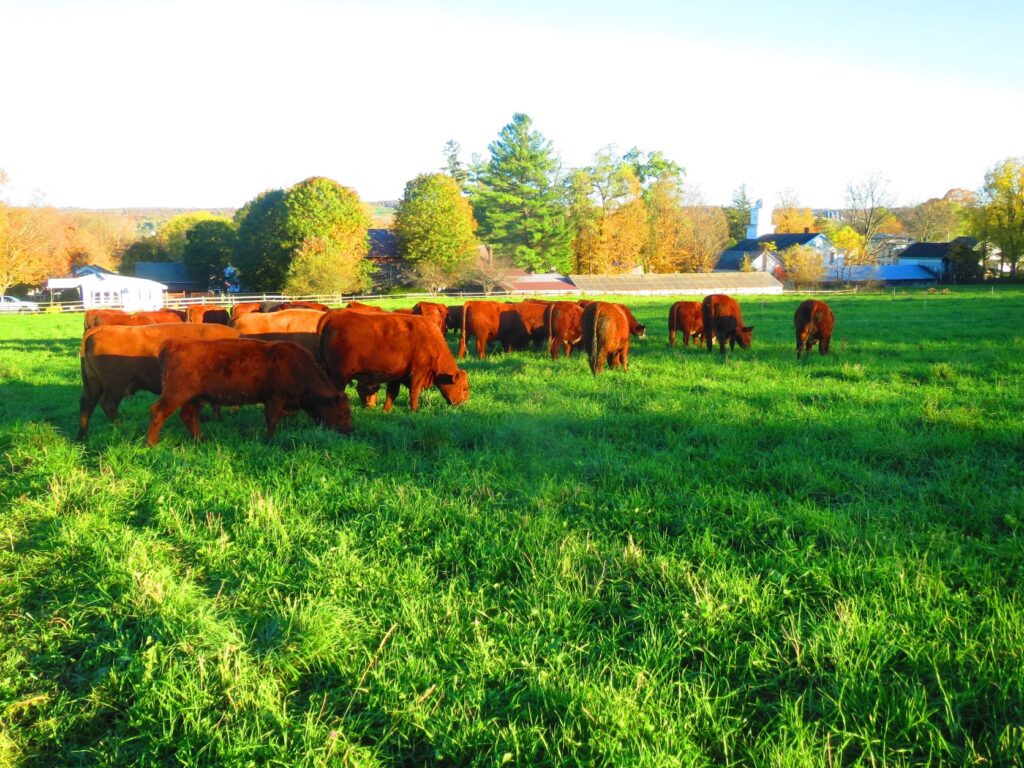
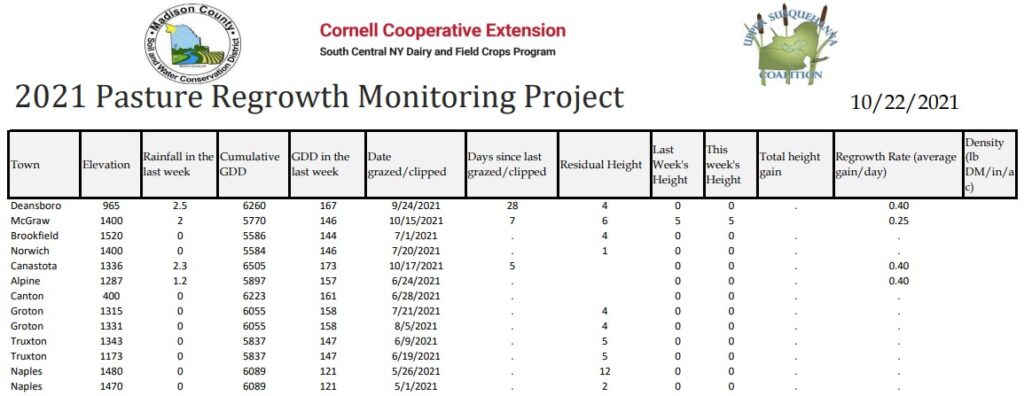
Pasture Pontification – 10/21/2021 – Still no killing frost (ten days longer than average). This past week was marked with 3 days of heavy rain and also beautiful 70 degree days. For us that want to graze longer, rain this late, isn’t exactly ideal. Mud forms around mineral feeders, fence breaks and watering points while every hoof that touches the forage is a potential non-bite or worm food. It’s ok for us, cause we have a plan to come back in another 20ish days to harvest one more time, weather permitting. The growth is slowing but I gotta say, the first 3 days after the graze period, the plants are still really excited to throw up new shoots. Great for building soil health, but if you just open up the gates without managing the recovery strategies and animal moves, those tender sprigs will be overgrazed by the overzealous livestock. Sadly, this is happening soooo many places in my travels and may limit progress of a grazing system for next year unless it’s a strategy to over-seed or frost seed. The week coming up looks wet and cool but no killing frost, unless you’re way up north. Because of the fine growing conditions and adjustment of stocking rate, I’m going to try skipping some paddocks in my grazing plan and let them go 58 days of recovery, especially because of the wet weather coming and wanting to set the stage for next year’s grazing start, ie: (striving to start grazing in the spring on the paddocks with the most rest in the fall). What you’ll see on my grazing chart battle plan is change and flexibility decisions made which are scrutinized every week now. For every frost-free day now, there are opportunities to work towards a goal. For me, the guy with over 35 years of experience, that means build stronger roots and plants whenever possible (environmental), put a few more dollars in the bank account (financial) and spending an extra few stress-free days with the people you love (social). Working towards what you want is a great foundation. Thoughtful decision-making is critical to this goal. What’s a good decision worth? I’ll let you ponder that. Thanks for listening. GW
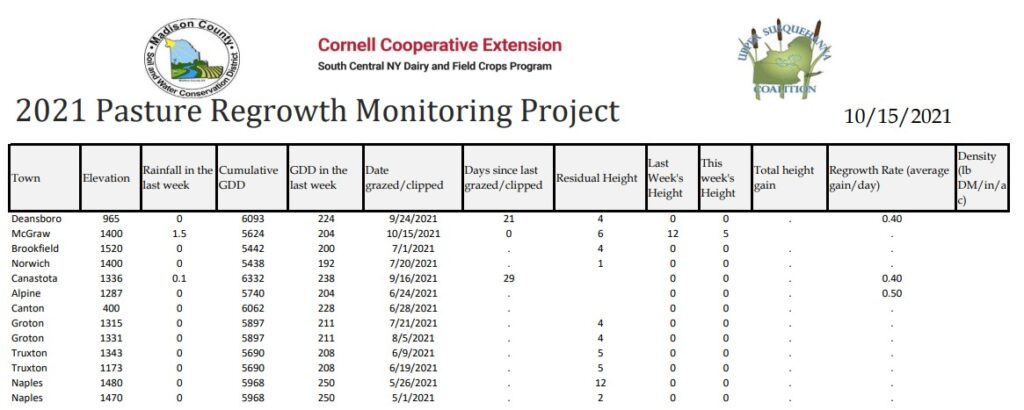
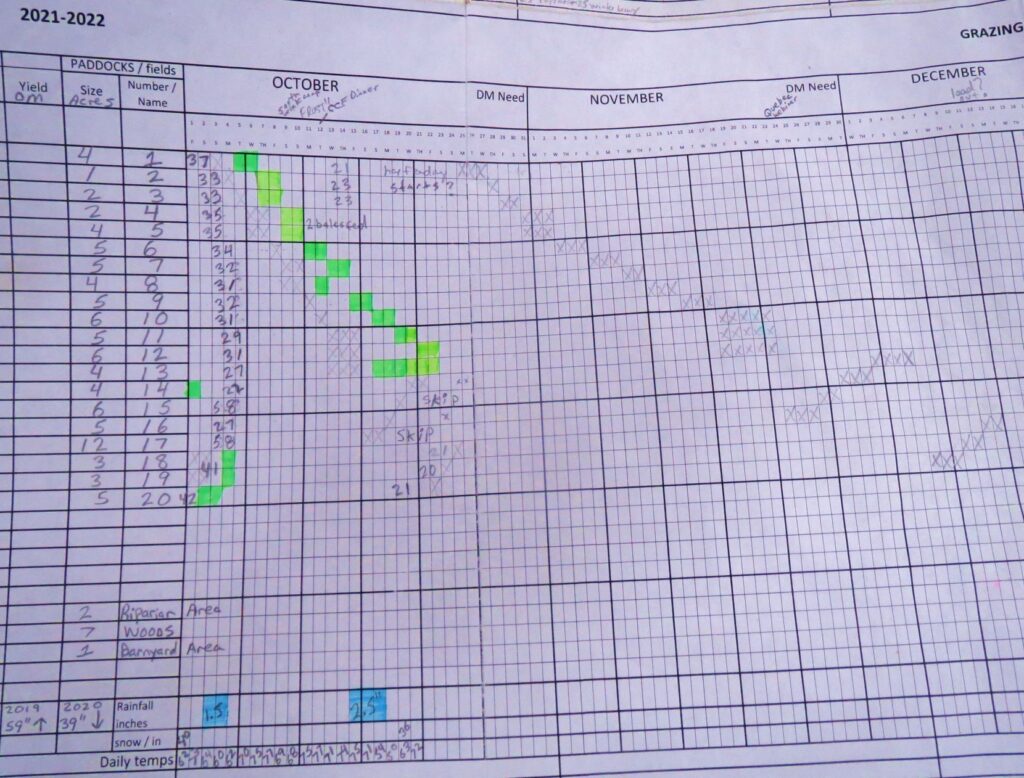
Troy’s Pasture Pontification – 10/14/2021 — Since the weather has been fabulous, we took our granddaughters on a fun-filled Columbus Day weekend camping trip to Southwick Beach (https://parks.ny.gov/parks/southwickbeach/maps.aspx) and since the cows couldn’t care less, my wife and I snuck away Monday to scout The Great Sacandaga Lake region for next year’s outings. I just learned that the word Sacandaga means “Land of the Waving Grass” in the local native language. How apropos. This lingering with a beautiful woman, sipping New York wine and eating New York cheese along the water’s edge is a benefit of having a farm, and perhaps a context, that is “right-sized” with our goals. Production and money are important but so is time to relax and take in life’s many splendors. It takes practice 😉. It’s also critical to build in some flex time to take advantage of a beautiful day or opportunity without guilt that the work doesn’t get done that day. There’s always gonna be work on the farm but ya gotta give yourself a break. The good news is we won’t be seeing any frost this week so the forage inventory growth continues, albeit slower from shorter days and upcoming cooler days. Our little regrowth project was featured in the GRAZE magazine this month as well as some commentary by Editor, Joel McNair on measuring and monitoring. Apparently, we may have hit a nerve amongst the grazing community. Included are the screenshots of the article for your perusing. It’s a great magazine that I have been subscribing to for many years. Check it out and support the paper: Graze magazine – the magazine that is by graziers, for graziers (grazeonline.com). Have a stupendous week. Thanks GW
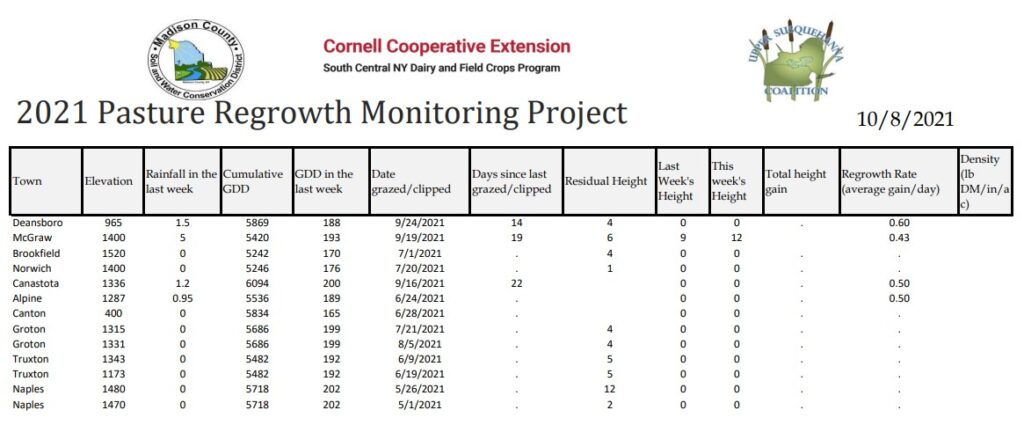
Troy’s Pasture Pontification – 10/7/2021 — Please, please take a few hours to enjoy the bounty of fall and the colors. “Notice that autumn is more the season of the soul than of nature”, ~ Friedrich Nietzsche. Regrowth is still going well (for this time of year), and if you have good residuals. I don’t see a letup for this coming week of moderate weather. Back on September 15th, I shared my fall grazing plan in pencil and wanted to follow up on what that “prediction” actually looks like in the field as I move forward into a 26ish day 5th rotation.
And as you look at the somewhat benign pictures, realize that our 40 said, 800-pound average animals are basically eating a third (or that’s what we want them to eat) of the mass. Most of the pastures have accumulated 3000lb. DM/acre and we want them to eat 1000lbs of it. So that means we are moving fast and occupation times are short and a 5 acre paddock will only see the cows for 1 to 2 days. Leaving a high residual and having grasses growing ½” per day still equates to me that in a 20 day fast rotation (without frost), we will accumulate back what we took. That’s the gamble I’ve chosen and you get to see how that is working out. Here’s a video I did in 2014 chronicling the forage inventory (https://www.youtube.com/watch?v=3lmn_23p1VE&t=23s) as another example.
I guess I would suggest you take a little walk around the farm, enjoying the colors and warmth, and see what your inventory looks like. For me, taking account of this inventory IS Money. For every grazing day here, it’s a fifty-dollar bill in our pocket. What might be your financial incentive for managing be? Thanks and have a good week, GW.

Pasture Pontification – 9/30/2021 – Hi and welcome back from my seasonal meltdown. Do you have such events? I’ve heard that you do sometimes. It’s understandable and I empathize with you. My internal self was helped immensely this week by hearing the legendary motivational speaker, Les Brown, who shared the truth about how everyone has to fail their way to success. SO many nuggets of inspiration (He Explains in 51 Seconds Everything That’s Holding You Back | Les Brown on Impact Theory – YouTube).
While my neighbors are chopping corn and harvesting the last cutting of hay, those happy grass plants are still chugging along at ½” of growth per day. My monitoring paddock finally saw the cows after 43 days of recovery and left behind a healthy residual so I can hypothetically graze it 2 more times in 20-ish day short intervals. Because of growth conditions, I’m able to gain some recovery time and reduce planned grazing periods which, in my mind, equals better plant and animal performance. It also makes my hunter friend happy as the turkeys and deer put on tasty pounds.
The forecast is holding steady as I approach my traditional frost date of October 10th. In 2020 it was an incredible October 30th and in 2019, it was an astounding November 4th. I’ll give you that there were cold mornings but as I have learned from the RIP Carbon Cowboy, Neil Dennis, healthy, dense, high residual swards have more resiliency against those 28-30-degree events. One problem to be aware of is, as those plants don’t go dormant (like you/I thought they would), they throw up growth on a warm fall afternoon and animals will want to graze them off if they can access them. This little grazing event can set your plants back in the spring so you must be attentive to this change and not just, “open up all the gates”.
My granddaughters have harvested from Nonna and Pop Pop’s pumpkin patch, leaf colors are giving us joy and evening campfires are toasty with no bugs so please enjoy the bounty that is before us. Thanks GW
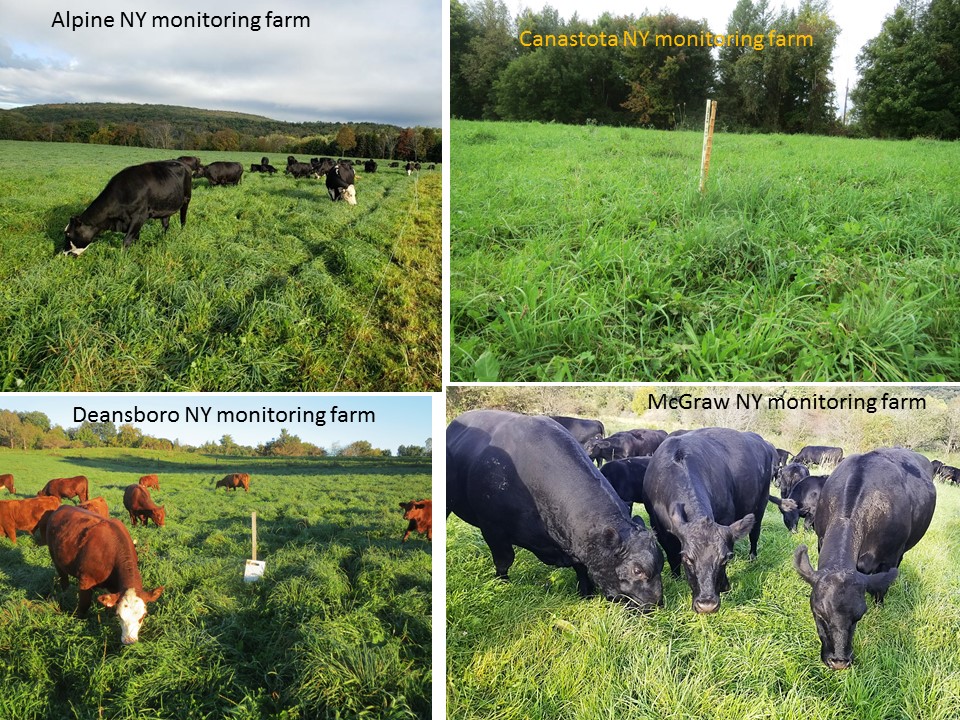
Pasture Pontification – 9/23/2021 – 16 years ago I took over the grazing program at Madison County SWCD with the vision that a “rising tide will lift all boats”. That first week, I got in a fueled-up truck and started making cold colds and meeting people where they are. Over the years, there have been many sold-out grazing conferences (who could forget “Graze-a-palooza”), countless pieces of practical grazing-centric information shared, many infrastructure projects put on the ground, professional training opportunities carried out and pilot programs initiated. The purpose? To build a community of land managers who prosper from making sound financial, environmental and family decisions that feed a local community and inspire the next generation. I think it is a solid goal even today.
But as I write once again at 3am, I’m starting to question the delivery method of these goals in a changed framework, where the customer sees me and treats me as a “tool” to get stuff. In my travels on this 16th anniversary, I see cows wallowing in “fenced-out” buffers, no grass in a year of absolute abundance, poor performing animals and grazing infrastructure destroyed. “Oh, you take your job way too personal,” they say. It IS personal because of all the countless hours of work done, on a premise to leave this place better for my grandchildren. I’m confounded like a bull in a China shop at what the incentive is for “managing” and how to get human behavior moving towards goals that matter. Author Seth Godin, talked about leadership and management in his keynote (https://www.youtube.com/watch?v=qzoIAJYPQwo). In it, he talked about taking responsibility and learning from it so we can become better leaders. The parallels are stunning!
With only 4 of us now participating, in this “Statewide” pilot, it’s clear we must ask the questions about its relevance and examine how to make it better, more useful, or scrap it and try a different approach to help customers. I’ve learned recently, you can’t keep using the same recipe, you must change and adapt to reach goals that matter. I hope there are many who will engage and brainstorm solutions for all our futures. Thanks GW
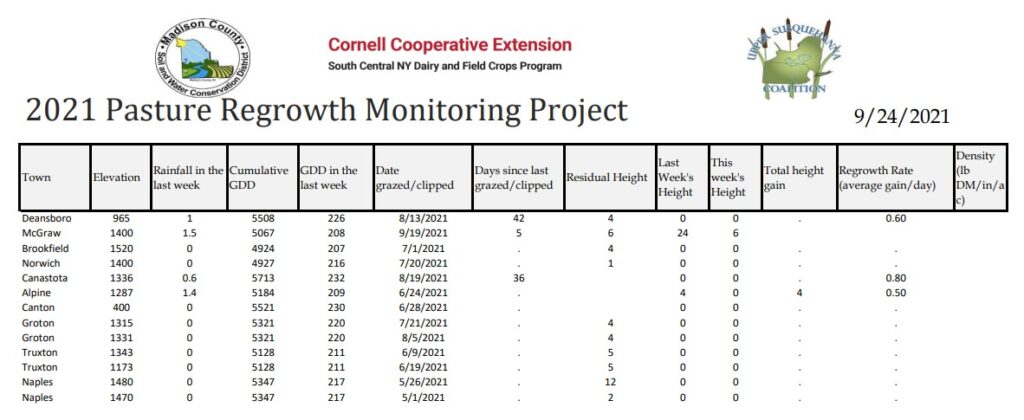

Troy’s Pasture Pontification – 9/16/2021 – It keeps raining and the pastures keep growing. However, the energy in the forage is lower and many are supplementing with a bit of corn or planted annual. The wild apples are fattening the steers as we speak. I gotta say, its been a fine grazing season. I hope it ends well with a drier fall so my stockpile doesn’t turn to mush from some wayward hurricane. The flies took a hit after some cold nights after Labor day which makes having a beer while moving cows a pleasure again. The colors are signaling some firewood cutting, painting, heating fuel ordering, buffer maintenance and of course, wine tasting and leaf peeping. Enjoy the fall season with friends and family. Thanks GW
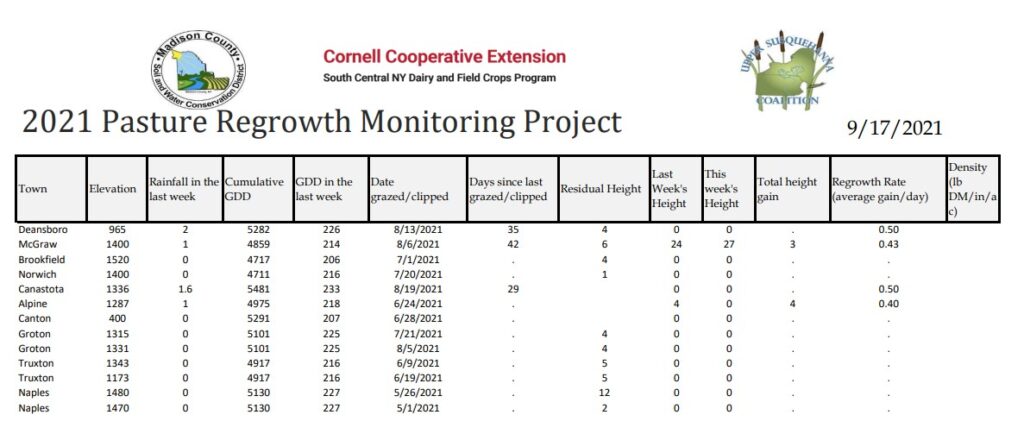
Pasture Pontification – 9/9/2021 Last week I pontificated at the campsite how the rest of my grazing season would play out, given what I know of moisture, growth rates, residuals, the hypothetical frost date (Oct. 10th) and what my gut experience is suggesting. So I planned out my season till December 10th in pencil. Then yesterday at Ryan and Annie Murray’s pasture walk, the conversation of how to manage the rest of the season came up. At my urging, I suggested to everyone they should walk their pastures (with other trusted friends) and glean practical information and “chart” their own plan to gain more inexpensive grazing days. It is hard to predict the future but there are knowns you can work around and then plan for the unknowns. I’ll share that the decision-making gets easier every year, but you need to start somewhere. Having a basic roadmap complemented with practical goals will make this exercise habitual and I suspect, more profitable in some way. I am including my 90 day plan so you can watch and see if I’m full of hooey or this mindset is close enough to my goals to be practical for someone to adopt. I’m willing to fall on the sword and see how the outside forces play against the plan. I’ve tried this exercise before with decent success. Find it here: https://onpasture.com/2018/09/10/can-you-be-a-grazing-soothsayer/ and https://onpasture.com/2020/01/13/how-a-grazing-plan-prevented-a-wreck/ “My grazing plan and my constant observations of what was happening in the pasture helped me make adjustments that were good for the grass and the animals. It’s this experience that I’ll take with me when I try something a little different again. It’s the try that matters most.” Have a great week, GW
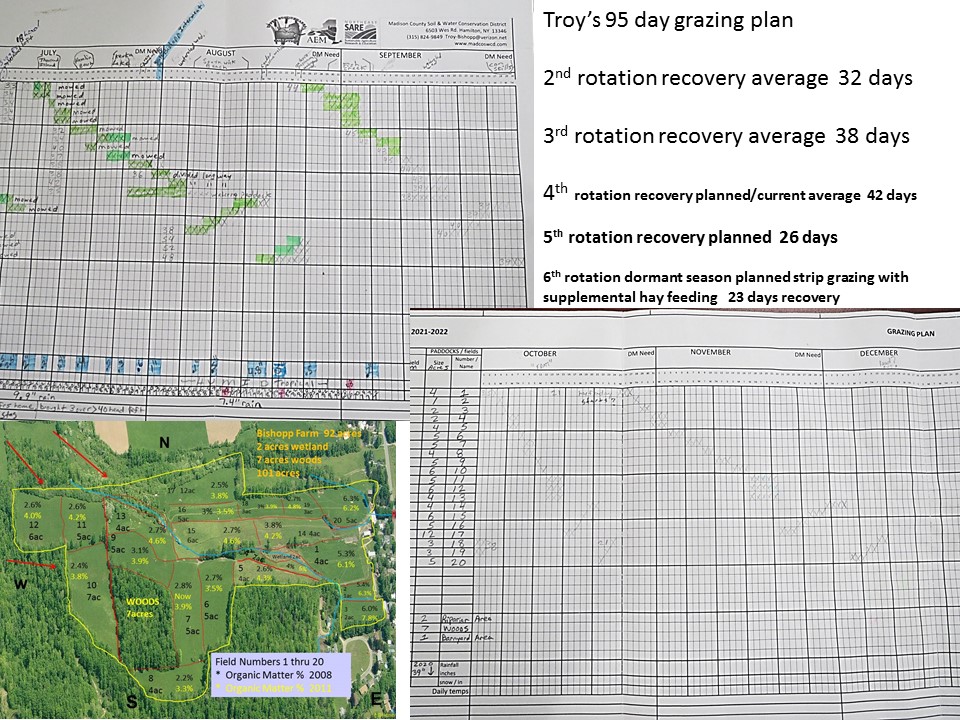
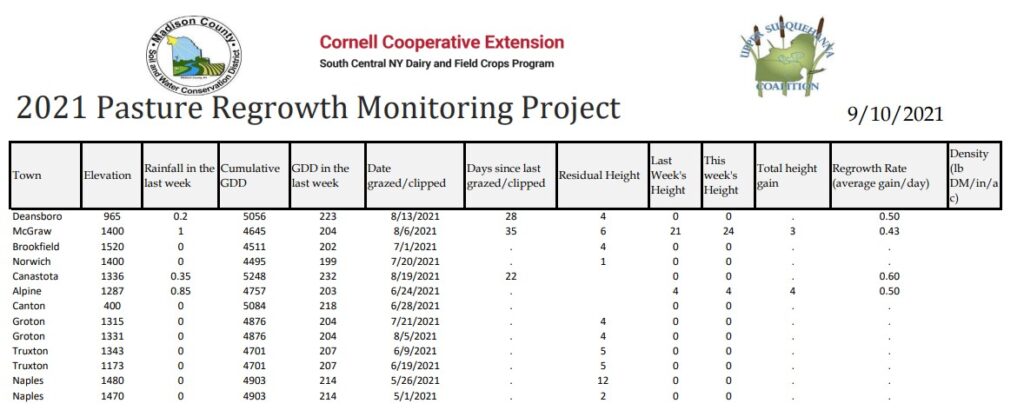
Pasture Pontification – 9/3/2021 Camping in the Adirondacks**
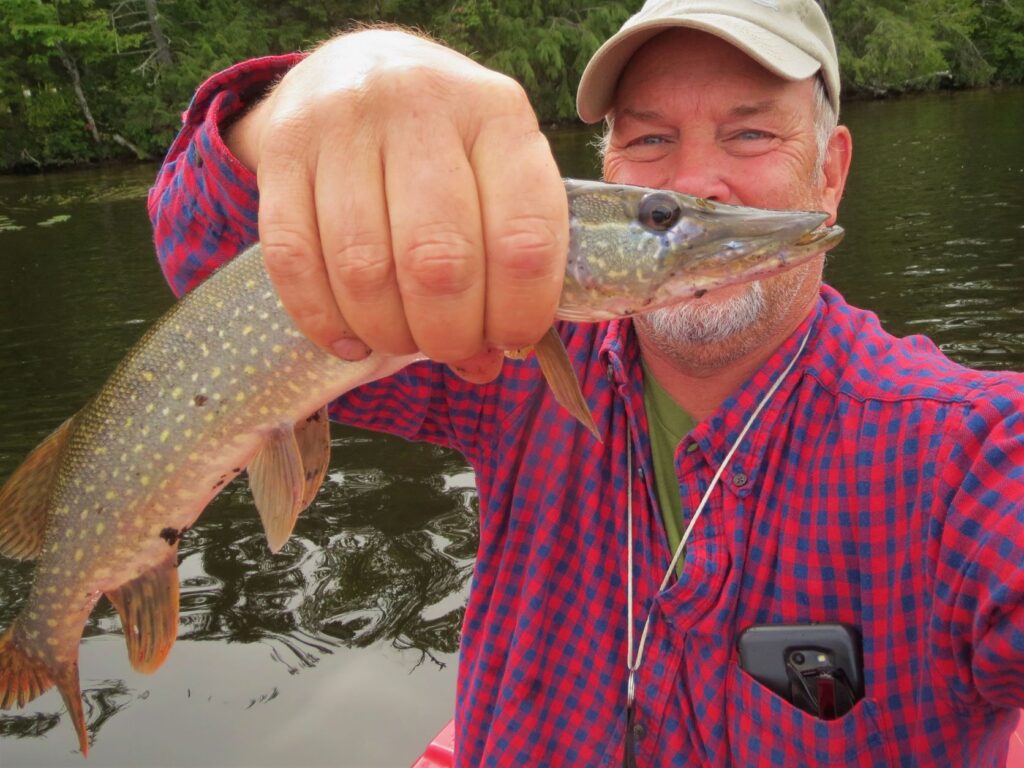
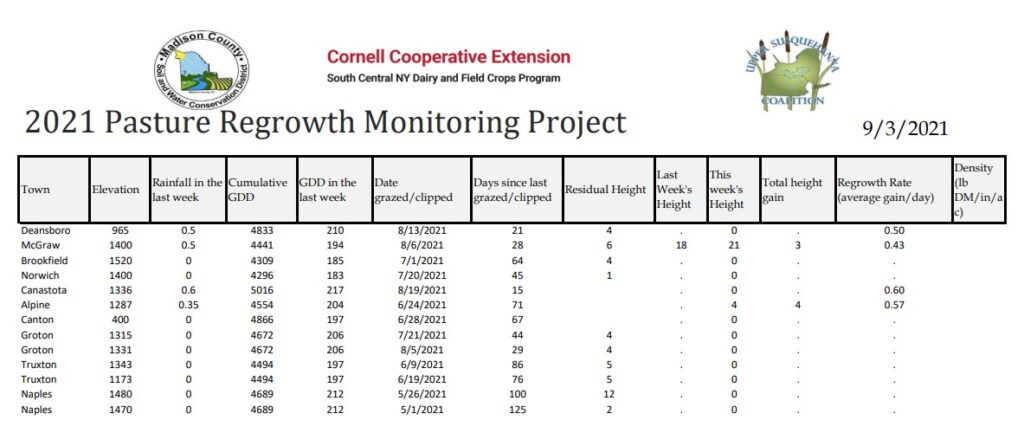
Pasture Pontification – 8/26/2021- After the rain and heat, growth rates around the region have been running 3/4” to 1” per day which is great news for stockpiling pasture into fall and early winter grazing. I just entered my 4th rotation with 44 days recovery and the forage is over 2 foot tall. Sure feels good to have plenty of feed enough to keep animal performance high, invest in soil health, build in more late season grazing days and once again, take a kayaking trip to the Adirondacks (https://www.canoeoutfitters.com/trip-planning/routes/rollins-loop ). Now the focus becomes, when will we think there will be a killing frost and how will we setup our paddocks during this upcoming 45 day growing period? I’ve taken different approaches in the past because of having a little extra land: Move all animals to rental farm and rest my home farm, rest specific fields while grazing normally in other paddocks (if we have enough moisture) or lightly top-graze plants in a fast rotation, in hopes they recover quickly, and graze off plants after the frost. Nowadays, I have one herd (40 cows) and one farm (90 acres), so I have to be quite strategic. I lowered my numbers from 55 head to 40 so I could more align with the “slower growth rates of fall” to build in more recovery time (45-60 days). I am contemplating the top growth fast grazing regime since we are recovering quickly which might give me 2 short grazings in this time frame and still give me an adequate grazing height and density, post frost. I could just plan in another 45 day recovery period and play around with grazing occupation times and stay flexible depending on weather conditions. I’m resistant to feeding some hay and locking down the beef finishers to a small slice of pasture daily for a fear of less weight gain. Labor day is usually one of my decision points in the grazing season to formulate the best path forward given what I currently know of my inventory and goals. If I were to have an extra set of eyes to help me make good decisions, it would be now, because every grazing day saves money on feeding hay. I’ll let ya know what I came up with when I figure it out on my grazing chart. Have a profitable week. Thanks, GW.

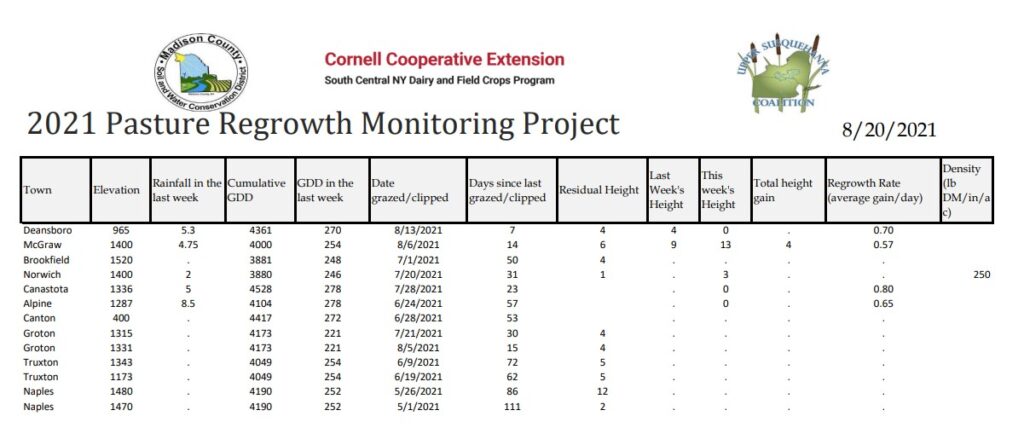
Troy’s Pasture Pontification – 8/19/2021- On a recent pasture walk in Candor NY, it was noted that the pasture season is going great with a measured inch of grass growth per day. Plenty of rain and timely heat and humidity has many a grazier smiling at their future inventory growth, when traditionally, August is considered a dry month. However, the forage is lush with protein rocket fuel and many grazing dairies are experiencing high MUNS (milk urea nitrogen) numbers (12-22). Most of us on these walks aren’t seeing many pumpkin pies on the land. This has precipitated some pasture management changes like feeding more hay/baleage at the barn or in the paddock, grazing taller, supplementing with corn silage or rotating thru some summer annuals with more starch value.
The recent deluges and intense humidity have some customers keeping their cows in the barn with full fans during the day and only grazing at night to reduce pugging and improve animal performance. My 10 day beach hiatus made me appreciate our pasture inventory accumulation management strategies. It made me think about grazing as a positive tool in the box for achieving specific goals. Most get all excited about “grazing”, but what is the end goal? For us, this planned growth phase in the grazing season was used for personal reasons and not exclusively just for financial gain. The environmental side was bolstered from a bit more trample and longer recovery periods, but without the intensity of cattle moves. I believe it’s OK to change the farming/grazing regime in order to meet your other interests of life. What I’m most excited about is seeing many of our pasture measurement professionals having fun at their county fairs, on cool vacations and get-aways, visiting friends, participating in weddings and sharing a measure of internal success that says to the world, “There is joy in agriculture when you plan for it”. Have a great week. Thanks GW
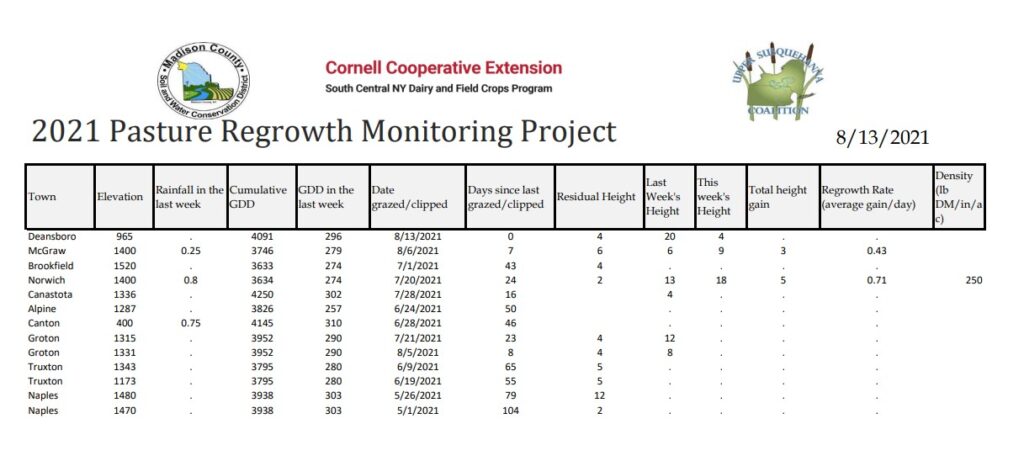
Troy’s Pasture Pontification – 8/13/2021 – (as sent to Betsy via text message from the beach – see photo below) “Just grazed, 40 day rest period. Rain? I dunno I’m on vacation.” Family vacation at Southwick Beach, Lake Ontario. Cows moved every three days by my grazing partner. Making beach memories every day and trying to recharge batteries. Have an awesome week.
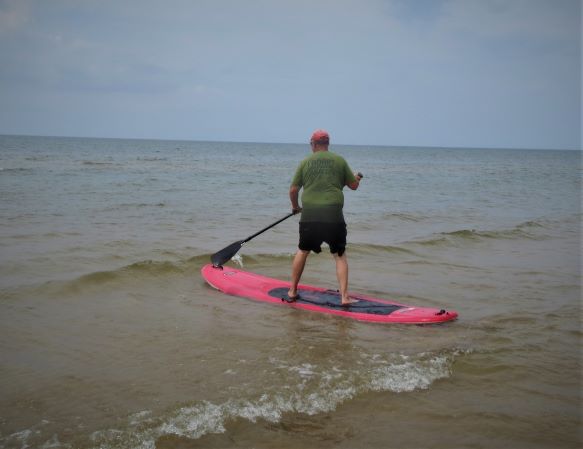
Pasture Pontification – 8/6/2021 — For us in Central NY, July’s rainfall total is in—9.9 inches. According to my grazing chart, that came over 20 days. Many farmers have noted the sogginess has retarded growth some, especially on waterlogged soil types. However, with good pasture residuals we have seen improved pasture growth rates and are able to grow the “haystack” in the field going into the stockpiling phase (60 days back from our fall killing frost). https://onpasture.com/2021/08/02/stockpiling-to-extend-the-grazing-season/
This week coming up is calling for a return to the high 80s’, lower 90s’ and drier, which is a pattern I’ve seen before, after significant rain. Then I ask the question: When will I get moisture in August and early September to grow some grass for winter grazing? Time will tell on how this growing period will play out. Thirty-six years of grazing experience suggests adding a planned recovery time to your paddocks now, when you have the moisture, and take a conservative approach. Things I’m doing include; dropping herd size (Sarah Flack says “variable stocking rate”, 55 head down to 40), making targeted impact on some rougher, hill ground that was fallowed last rotation with tight paddocks and a little hay feeding gaining some additional fertility, and keeping cows in a take half-leave half mentality with frequent fence moves.
Adding outside amendments, at this time, to increase dry matter forage/acre is definitely on the radar. According to my soil tests, my crop advisor is suggesting spreading 175 lbs./acre of 15-50-20-15sulfur &.5boron. It’s about $62/acre that I spread myself. I’m interested in applying this mixture to the worst knapweed fields and run a side by side trial to see if added fertility at different rates diminishes my nemesis. I’m still battling my inner demons and the regenerative agriculture gurus who say not to upset the natural biology with conventional fertilizer. Guess I’m prime for a pilot project of what the heck to do :). As you read this, my pasture regrowth monitoring area will be flush with 900 pound grass finishers munching away on the bounty while we enjoy a family vacation. Grazing planning is more than grazing ya know. Have a profitable week. Thanks GW
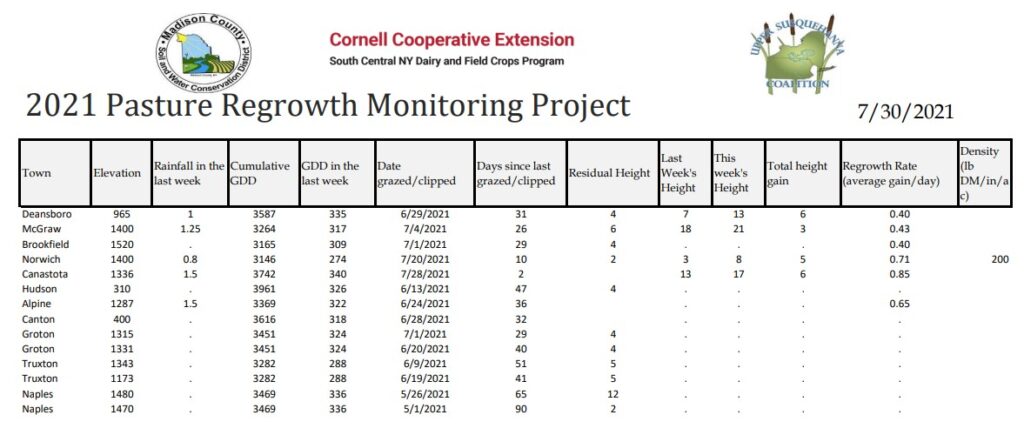
Troy’s Pasture Pontification – 7/28/2021 – I’m afraid my focus this week is returning my brother’s ashes back to the earth and preparing the sod for his final resting place in the Deansboro Cemetery. It’s a bit ironic that my nephew, Derek, my dad and I, did this in the pouring rain—A metaphor for the tears we are shedding this weekend as a family. I work in the rain so no one can see me crying. Charles Dickens used to say, “Heaven knows we need never be ashamed of our tears, for they a-re rain upon the blinding dust of earth, overlying our hard hearts.” The cattle and pastures are doing quite nicely which gives us time to mourn. I’ll leave you today with this from my brother, Scott: “True values come into existence when we realize how well our parents have raised us, and we pray that we can instill in our children the values that were instilled in us. I think there is only one value that is universal; that is happiness. All other values are a product of our desire to achieve that one elusive value. I believe in Thoreau’s statement: “That if one advances confidently in the direction of his dreams, and endeavors to live the life he has imagined, he will meet with a success unexpected in common hours. For me this has proved to be true.” Thanks GW
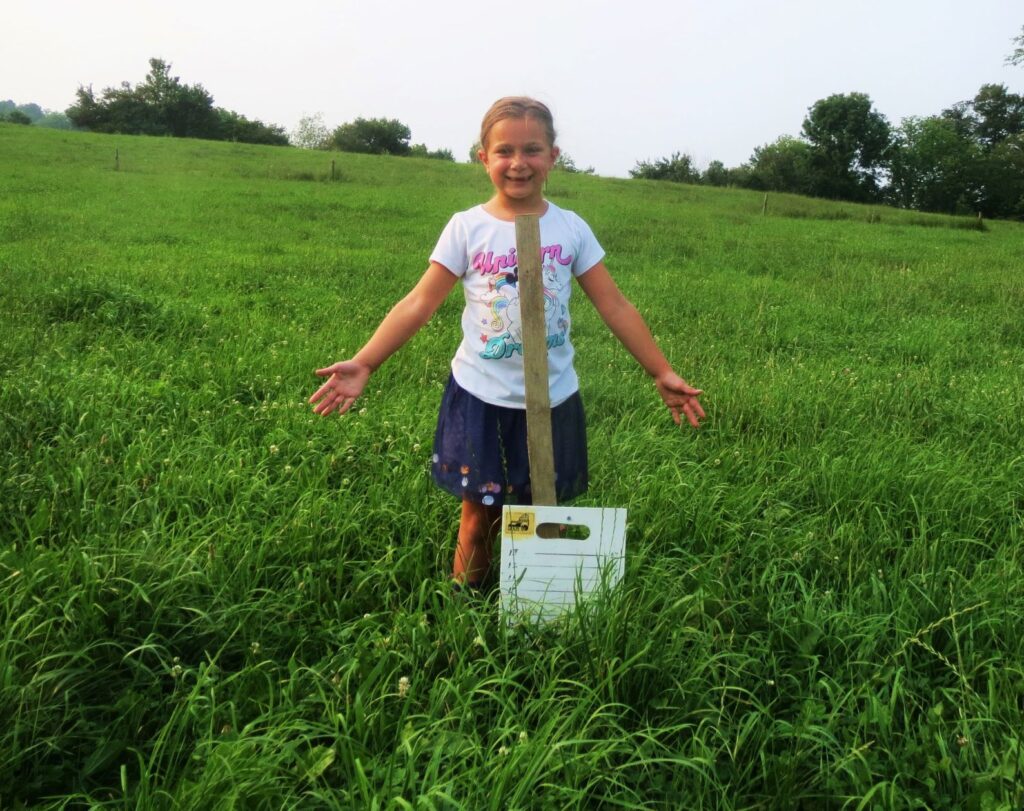
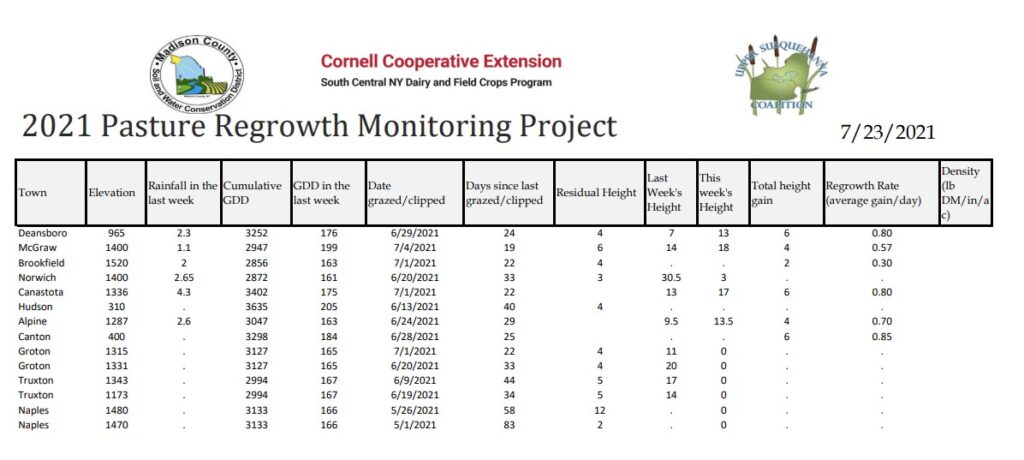
Pasture Pontification – 7/21/2021- June 23rd to June 28th was the last stretch of dry, sunny weather. Since then I have received 9.8 inches of rain over 21 days, some in buckets—some in drizzles. The humid weather has made for excellent grazing quality and spurts of immediate growth after one day of grazing recovery. In 3 days or less, we need to be moving cows on to the next paddock for fear of over-grazing the tender regrowth. My attention now is to help guide the cows and the grazing plan around family events, vacation and upcoming pasture walks that will take me away from the farm. It’s pretty great to accumulate quality forage inventory in this soggy period to use it for animal and human performance. August 10th is an upcoming decision point in the season as this is 60 days back from our fall killing frost date average. This planned accumulation of forage is a key driver to getting more grazing days beyond the growing season and must be on our minds as we push forward. For me personally, my wife and I just celebrated our 35th wedding anniversary, and to this end, I couldn’t live without my incredible life partner and best friend who supports my grazing habit and workaholic tendencies. So while the cattle are happily grazing, I’m thinking we’re going to accumulate some needed, “wine and lake days”. Have a powerful week. Thanks GW
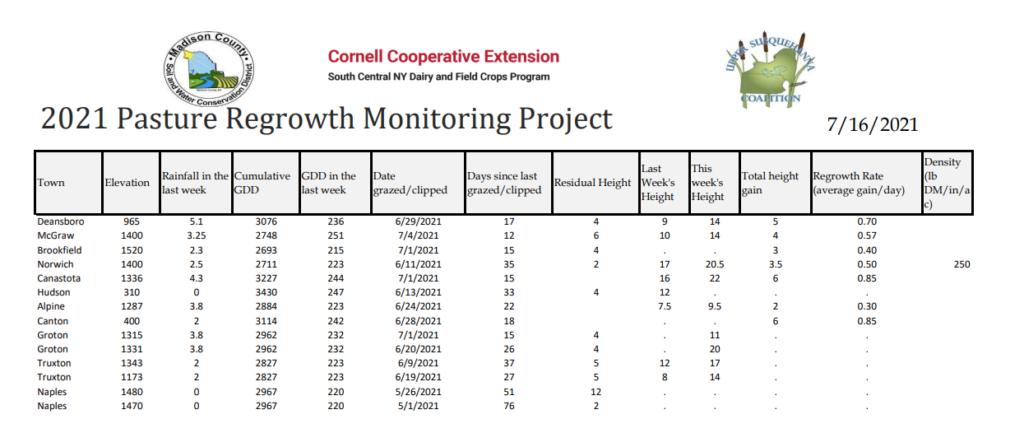
Troy’s Pasture Pontification – 7/14/2021 – It was heard, “We need our snorkels to move the fence for the cows”. My, what a change of events we have seen since the “D” word reared its ugly head. I’ve seen the cool season grasses take off after grazing as well as a surge of clovers enjoying the moisture. For a mixed sward, quality is good and dung beetles are maximizing their joyful swims. This is a period when flies become abundantly annoying. I have been trying garlic powder mixed in salt, a product called “Salt Buddy” from Grass Farmer Supply, diatomaceous earth mixed with kelp once a month and the ole’ weatherproof fly tape curtain https://www.youtube.com/watch?v=1FdhD0ssS0I&list=PLw3mwuQSHH0wNfso0–u6orX2MZeQX-jk&index=16 plus the dung predators and birds to combat the rise in fly populations. I have observed that our land has infiltrated the 5 inches of rain with hardly a rise in our on-farm streams which makes me extremely happy. However, I’ve seen many farmers that aren’t so fortunate because of the sheer intensity. After being through these types of rain events many times, there also seems to be an extended dry period that follows just about the time that I need moisture to stockpile pasture for fall and winter grazing. Hopefully that doesn’t happen, but I’m planning that it does and I’m utilizing this surge in growth combined with a planned extended recovery period to accumulate more inventory. If I play my cards right, I will be able to truly graze just the tops of plants and leave higher residuals every rotation from now on. But for now, my grazing plan calls for another camping trip to Lake Ontario where I can ponder decisions over a whiskey and a fishing pole. Have a great week. Thanks GW
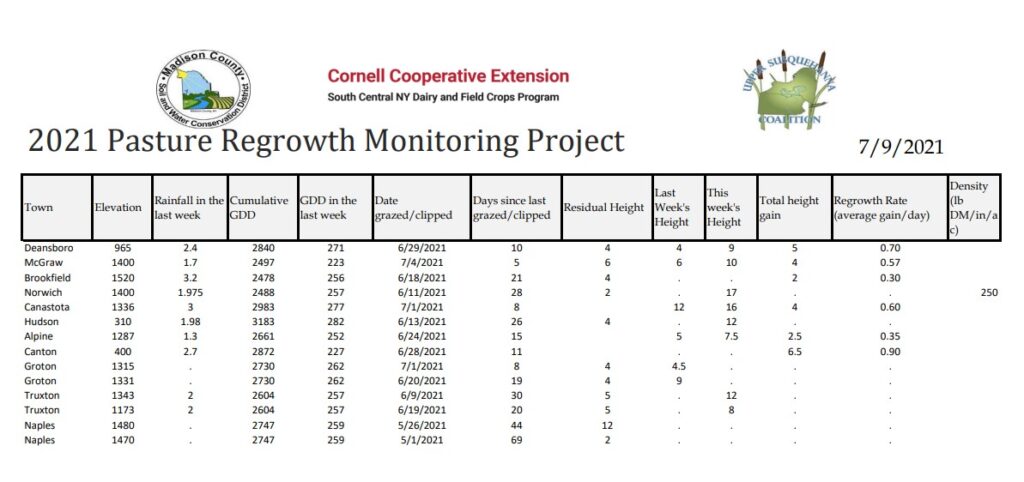
Pasture Pontification – 7/7/2021 The current weather and ongoing pasture management continues to be a chess match. We’re still clipping behind the cows in an attempt to thwart the knapweed florets and other susceptible weeds. In his 1955 classic book, “Fertility Pastures”, Newman Turner suggested “topping off” pastures and leaving behind a nutrient-rich surplus of nutrients from these and other deep-rooted plants that have “mined” everything the sward needs naturally. In his opinion, “the only essential is organic matter”. “Organic nitrogen, phosphates, potash, even calcium in small but usually adequate quantities, are supplied in the process of decomposition of organic matter.” This sentiment helps to (sort of) justify the countless rounds of mowing. If you have given your pasture plants adequate nutrition and recovery, last week’s rain events has your profit center rebounding nicely. I’m accumulating over 150 lbs./DM/acre inch/day from maintaining a practical grazing plan. And as we get deluge after deluge, this environmental champion sward is sequestering and storing the moisture on the land for future use and helping to mitigate community flooding concerns. The most important component of our grazing plan is taking shape as camping (CDs) and grandchildren days (GDs) are upon us. I was thinking that if you are doing a lot of planning and don’t hit your targets very often, you tend to quit keeping proactive. When we hit our personal, financial and environmental goals repeatedly, it’s actually fun to plan, cause you know you’ll have a good recipe for success. The rub, for me, comes to bear when folks get “envy” for what you plan for and achieve and feel compelled to scorn success instead of celebrate it. It’s the herd mentality we need to avoid while letting the “lingerers” have their day and show what is possible, from managing wholes. Have a great grazing week. GW
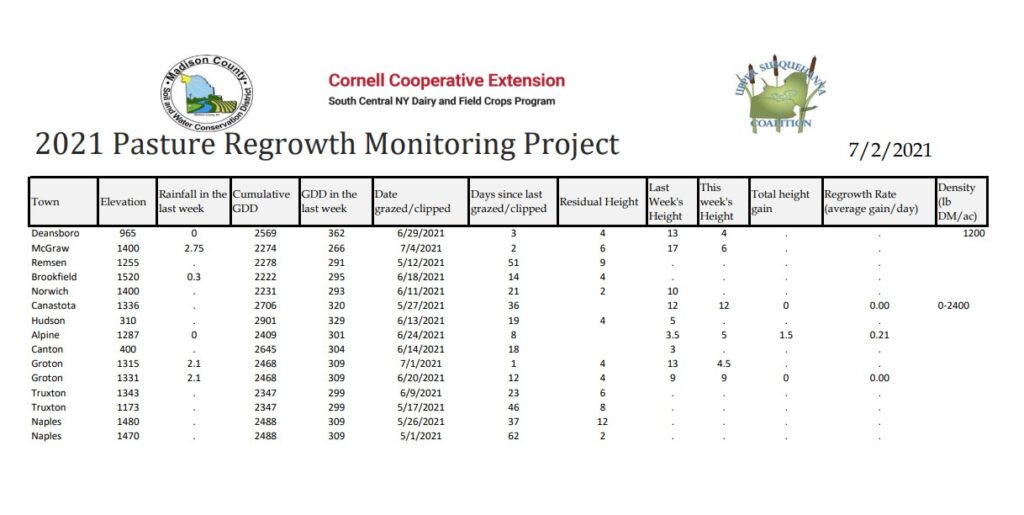
Pasture Pontification – 6/30/2021 In our area we have gone a week without rain except for some big rain “plops”. I know others are near to or just had significant thunderstorms as I write this. And that’s good. However, the trend over the last grazing cycle has been only a tenth or two, here and there. Couple that with 2 ninety degree heat waves and you have a slow growth phase. Those raindrops play a trick on you into thinking since it “rained”, it will be OK. Pastures just don’t shoot up after a scant rain, it takes time and needs recovery time that is planned by folks with the big brains. Now is the time to really keep up the monitoring from all sources of pertinent information and on your own land to be able to predict pasture inventory based on actual data and keep making good profitable decisions. Sadly, monitoring is not a high priority as other activities occupy time. Many pastures I see, have hit the proverbial wall (taken too short and then it didn’t rain) leaving the soil exposed to evaporation, low biology and diminished water holding capacity. Resiliency is in knowing the truth of the current situation and proactively managing toward the goals and mitigating risk. This weekly growth rate snapshot is an important first step in identifying solutions to potential threats to your grazing operation’s bottom line. Thanks GW
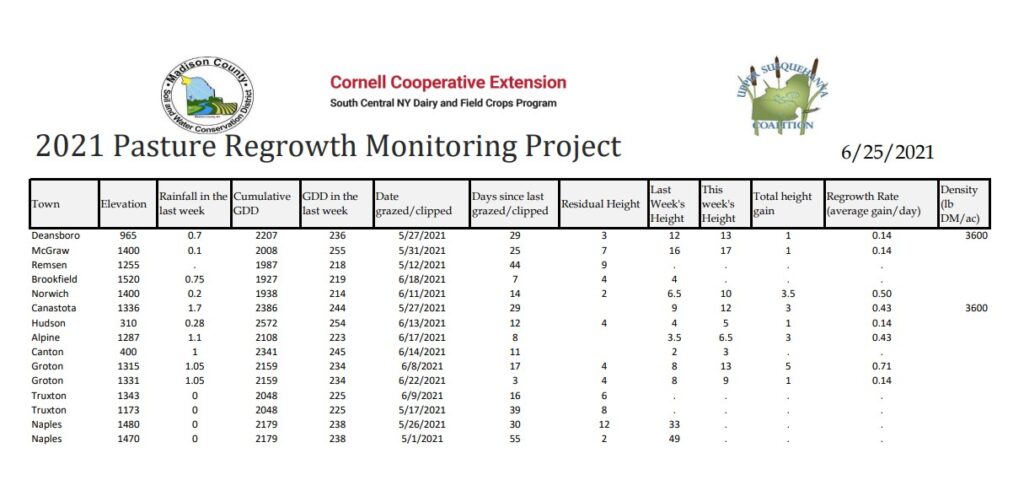
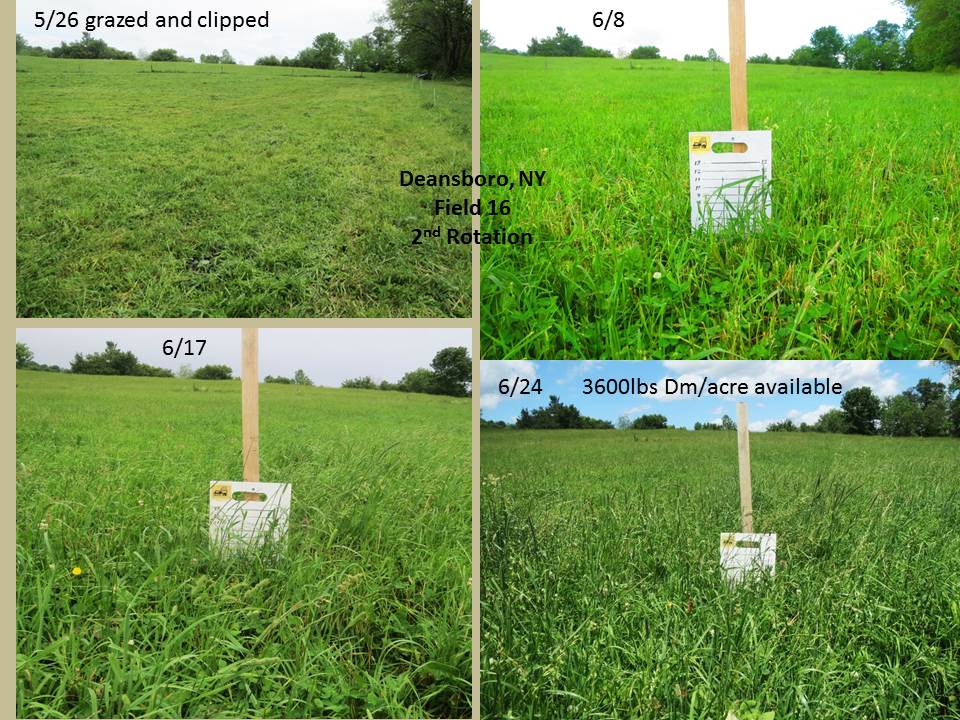
Pasture Pontification -6/24/2021 The latest Northeast Drought Monitor (https://droughtmonitor.unl.edu/CurrentMap/StateDroughtMonitor.aspx?Northeast) is showing dry conditions creeping north to south and west to east, so planning in a longer recovery period should be considered. Our monitoring farmers have seen regrowth slow in those areas with spotty showers. Moving past the 4th of July, my 3rd rotation is scheduled to be a 50 day recovery period. If it rains nicely great, but if not, I’ll be in a better position (cross my fingers). I am measuring density plus height in my monitoring spot, just to give folks a different perspective, because I have a diverse plant community and I believe they grow at different rates and sizes. Interestingly, I measured a heavy orchardgrass area in another field with a 5 inch stubble height (clipped) and it was re-growing an inch a day. I’m also still fighting to control knapweed and I see my old friend, Mr. Horsenettle has come back for his yearly visit. There’s still a lot to learn on how to make the best pasture using all the tools and recipes. Guess I’ll ponder them over a beer and campfire. Thanks GW
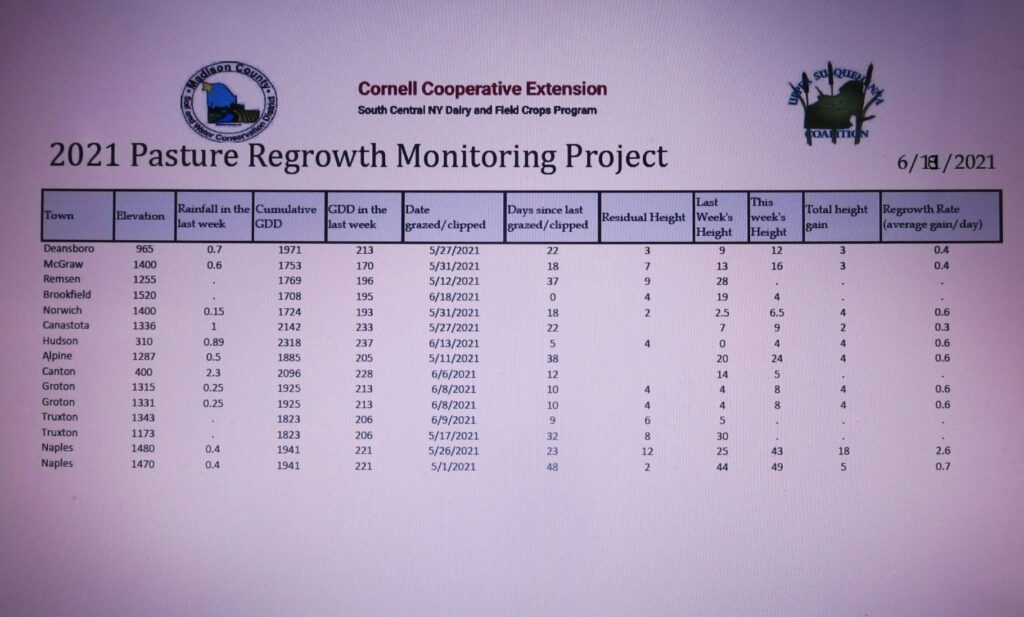
Troy’s Pasture Pontification -6/17/2021 As the summer solstice greets us, a measuring ah-ha moment came into my lens. My sward has taken the opportunity to “thicken” instead of just elongating the leaves. Seasonal legumes, forbs and tillering grass plants have contributed to a positive density per acre inch. This transition in species richness is a bit of a head scratcher when measuring because the grass leaves have slowed while other plants are moving laterally. I’m getting feedback to see if the measuring regrowth metric should change to include density. Some have suggested we clip and weigh, some have suggested a rising plate meter, my friend Victor, told me about using the weight of a clipboard to measure while others talked about using the dots on the pasture stick. Our grass nerd, Samantha Glaze-Corcoran from U/Mass said we should stay the course with measuring grass leaves weekly. She suggested we might measure different grass species and do an average growth rate. She also said that indeed the grass growth will slow down as the season changes, and we better be planning in recovery periods to reflect that. It will also depend on fertility, residual height, soil types, grazing regimes and the proverbial, heat and rain. https://onpasture.com/2018/06/25/figuring-out-how-long-pasture-recovery-takes-part-2/ . I am considering what my next recovery period will be as we monitor. I’m really confident it won’t be 30 days. Here’s hoping you have copious amounts of timely rains but a beautiful Father’s Day. Thanks GW
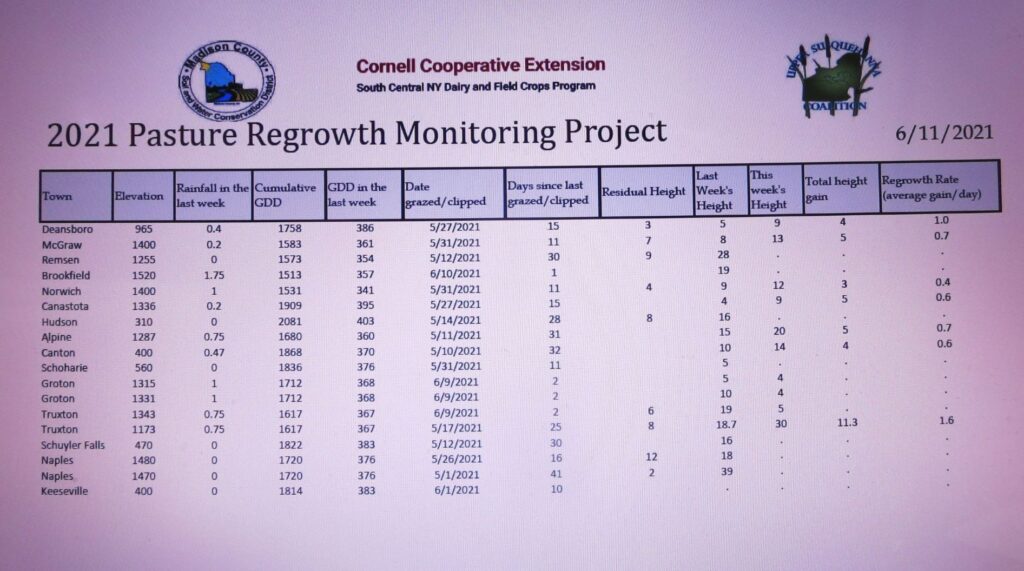
Pasture Pontification -6/10/2021 There has been a lot of, what seems as stress, in dealing with headed out forage. Hay it, clip it, trample it, roll it, give it away, add animals, leave it for the birds and soil health or whatever, has folks on many list-serves searching for the right recipes to set the plants back to a quality vegetative state. After talking to ranchers out west in the “mega-drought”, consider yourself really fortunate to have so many options in dealing with overabundance. I’m hoping that this stress of too much will propel you to create some great planning scenarios that will bring more profit or save you money and make for a diverse environment because nature won’t just let it go to waste. You may be intrigued by my last year’s observation (https://onpasture.com/2020/11/30/what-is-the-true-meaning-of-grazing/). Keep monitoring the growth rate amidst the thunderstorms and keep forecasting ahead so you know your inventory for the next month because sooner or later another dry period is bound to happen. And take so time off!!!!
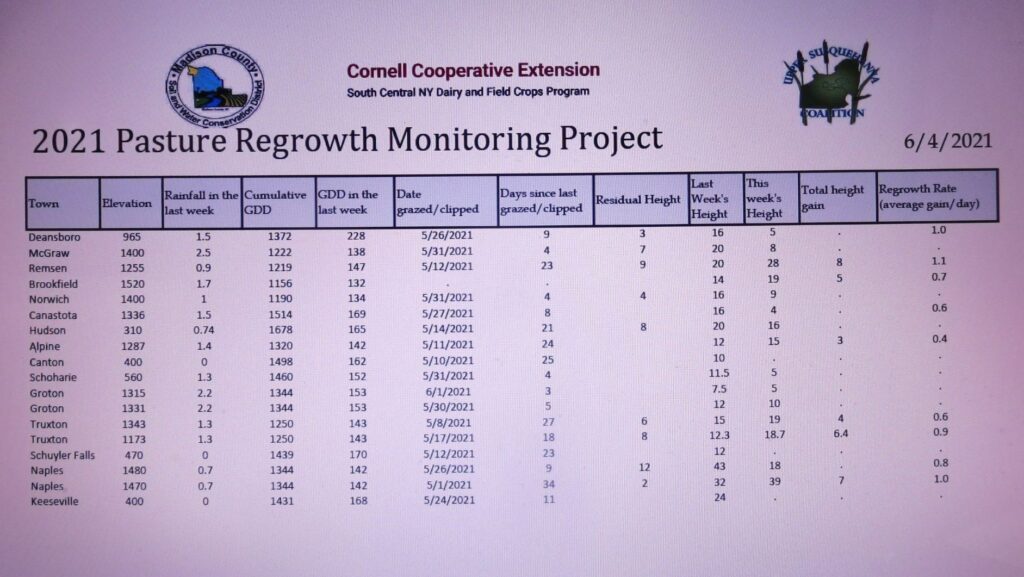
Pasture Pontification -6/2/2021 There’s a saying I bore my family with: “Rain makes grass and grass makes me money”, so I like a good “money” rain. After 12-14 days without moisture and a fleeting thought of possible trouble, I was relieved we got some. My planned 1st rotation was to be around 23-26 days but ended up being 28-30 for most paddocks. I am currently mowing behind each paddock shift to reset the sward back to 4-6 inches and clip those still green seed-heads. I’m also doing a little experiment of raising up the cutter bar higher as I go (say 7-10 inches) to see what effect that has on regrowth rates and quality. Victor Shelton of Indiana NRCS, discusses this in his most recent pasture talk muse: “Raise the mower up enough to, ideally, only remove stems and seed heads and very little leaf matter. Once leaf matter is removed, regrowth slows some because of the removal of good photosynthetic plant material. Removal of stems and seed heads should not be a large amount of material.” With the impending heat wave coming this weekend, I see another opportunity for explosive growth and many locations getting in their winter feed and optimizing animal and plant performance before the summer solstice starts. Pretty much all of us are straight out with work, so monitoring has fallen behind as a priority—especially with so much forage to harvest. I’ll just say it’s normal to maybe fall behind a bit. We’re human. Try to enjoy all the growth, the beauty and the reduced stress from having abundance in your life. Maybe it’s time to open up a bigger paddock and take a day off to go fishing or swimming or have a barbeque. Thanks GW
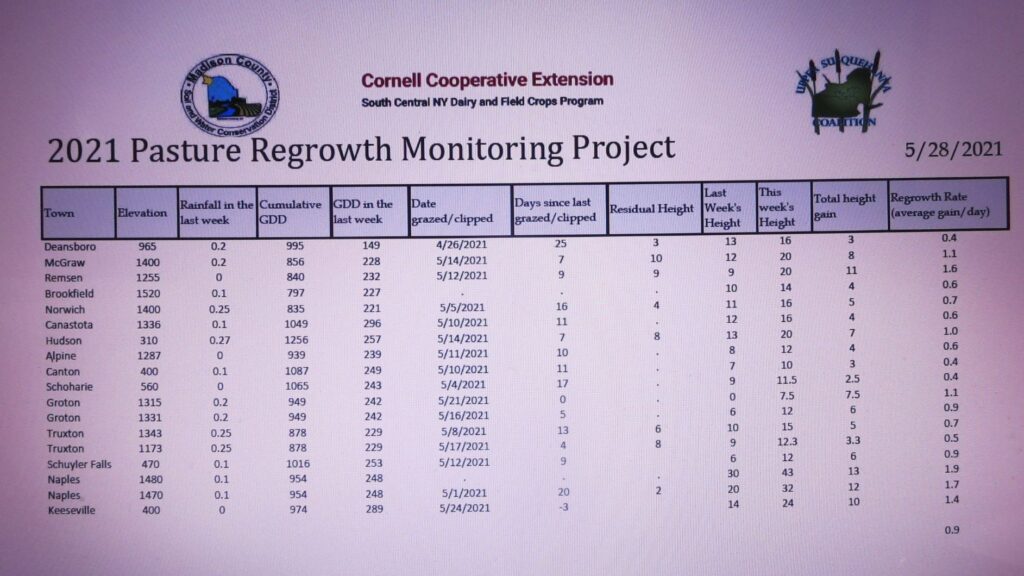
Pasture Pontification -5/26/2021 As I write this, a hefty thunderstorm is dumping some much appreciated rain in Central NY. Most fellow farmers are turning 25 to 30 day recovery periods going into their 2nd rotation while seed-heads abound! Some have enough animals to keep the pastures at a 4 inch residual while many, (including myself), have excess forage giving animals the opportunity to perform to optimum levels. Excess forage is being cut for hay, trampled in for soil health, pruned and left on pasture surface and even deferred for grassland bird habitat. There has been increased chatter about the lack of rain but no real strategies have been implemented as of yet. I have been confounded by well-grazed Orchardgrass still throwing up a seed-head even at 6 inches. It’s perplexing to think you’re keeping good vegetative growth, but in 2 nights of warm weather, the pastures exploded. Never underestimate the power of Mother Nature. I have these thoughts on the table for explanation: Do warm nights drive the growth more than days? If we graze or mechanically harvest green, tender seed-heads, will the plant stay vegetative or have we lost regrowth potential? Darrell Emmick suggested 1 inch of daily pasture growth is expected in the spring. If we are at half that growth rate is it indicating dry period stress? What is a growth rate that would signal a major repositioning in a grazing plan?

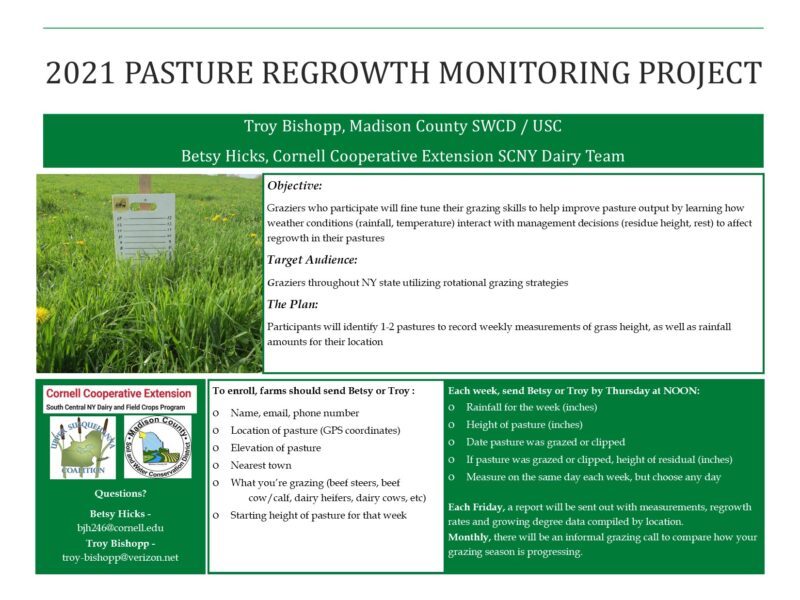
 Sunset Transformation is Hard
Sunset Transformation is Hard »
»